Understanding the Glass Ceiling in Leadership Roles
The concept of the glass ceiling is a metaphor that has been used for decades to describe the invisible barriers that prevent women and minorities from ascending to the upper echelons of the corporate ladder, regardless of their qualifications or achievements. This phenomenon persists across industries, manifesting in various forms of discrimination and bias that hinder the professional growth of talented individuals. In this blog, we delve into the intricacies of the glass ceiling, exploring its effects, the barriers it creates, and strategies for overcoming it to foster a more inclusive and equitable professional environment.
The Glass Ceiling Effect: Statistics and Real-World Examples
Despite significant advancements in workplace equality, the glass ceiling remains a stark reality in the modern professional landscape. A glaring example of this is the representation of women in leadership roles within Fortune 500 companies. As of recent data, only 7.4% of these companies have female CEOs, a figure that starkly highlights the gender disparity at the highest levels of corporate leadership. This underrepresentation is not just a statistic; it reflects the systemic obstacles that women and minorities face, including entrenched stereotypes and biases that question their leadership capabilities.
Real-world examples abound, illustrating how qualified individuals are often overlooked for promotions or leadership opportunities due to these invisible barriers. These instances are not isolated but part of a broader pattern that affects numerous sectors, from technology and finance to healthcare and education. The persistence of the glass ceiling not only undermines the potential of talented individuals but also impacts the overall innovation and performance of organizations.
Barriers in Leadership for Women and Minorities
The journey to leadership is fraught with challenges for women and minorities, stemming from deeply ingrained societal norms and corporate cultures. Gender and racial biases are pervasive, subtly influencing hiring decisions, performance evaluations, and opportunities for advancement. Women, for instance, often encounter stereotypes that question their assertiveness or leadership style, while minorities may face prejudices that doubt their competence or fit within the organization.
Moreover, the lack of mentorship and sponsorship opportunities further exacerbates these challenges. Mentorship is crucial for career development, offering guidance, advice, and support. However, women and minorities often find it difficult to find mentors and sponsors within their fields, limiting their ability to navigate the corporate landscape and advance to leadership positions.
Societal expectations about gender roles also play a significant role in perpetuating the glass ceiling. Women, in particular, may face expectations to prioritize family responsibilities over professional ambitions, creating additional hurdles in their career progression. These barriers are not only detrimental to the individuals affected but also to organizations that miss out on diverse perspectives and leadership styles.
The Psychological Impact of the Glass Ceiling
The effects of the glass ceiling extend beyond professional development, impacting the psychological well-being of those it affects. The constant battle against invisible barriers can lead to decreased job satisfaction, lower self-esteem, and increased job stress. The frustration of encountering systemic obstacles, despite one’s qualifications and efforts, can be demoralizing, leading some to question their capabilities or to opt out of the leadership track altogether
This psychological toll is not only a personal issue but also a professional one, as it can result in the loss of talented individuals who could have contributed significantly to their organizations. The cycle of underrepresentation and its impacts perpetuates itself, making it crucial to address not only the structural but also the emotional aspects of the glass ceiling.
In the next sections, we will explore strategies for breaking through the glass ceiling and the societal benefits of achieving greater diversity in leadership roles. By understanding and addressing these challenges, we can pave the way for a more inclusive and equitable professional landscape.
Strategies for Breaking Through the Glass Ceiling and Societal Benefits
Breaking Through the Barrier
Overcoming the glass ceiling requires a multifaceted approach, combining personal initiative with systemic change. Here are key strategies that have proven effective:
- Mentorship and Sponsorship: Seek out mentors and sponsors who can offer guidance, advocate on your behalf, and open doors to new opportunities. These relationships are crucial for navigating the complexities of corporate environments and advancing in your career.
- Skill-Building and Continuous Personal Development: Commit to lifelong learning and skill enhancement. This could mean pursuing additional qualifications, attending industry conferences, or developing new competencies that align with leadership roles.
- Building Personal and Professional Brands: Establish a strong personal brand that highlights your unique skills, experiences, and leadership vision. A compelling professional identity can set you apart in a competitive field and attract opportunities.
- Networking and Forming Strategic Alliances: Cultivate a broad and diverse professional network. Connections can provide support, offer insights, and facilitate introductions to influential figures in your industry.
- Advocating for Oneself: Develop negotiation skills and learn to advocate effectively for your career advancement. This includes articulating your achievements, making your aspirations known, and negotiating for promotions or leadership opportunities.
Societal Benefits of Diverse Leadership
The push to shatter the glass ceiling is not just about individual achievement; it has profound societal implications:
- Diversity in Thought and Innovation: Diverse leadership teams bring a range of perspectives, fostering creativity and innovation. This diversity of thought can lead to more effective problem-solving and drive breakthroughs in products, services, and strategies.
- Thriving Companies with Inclusive Leadership: Evidence suggests that organizations with diverse leadership are more successful. These companies often report higher profitability, demonstrating that inclusivity is not just a moral imperative but a business one.
- The Pay-It-Forward Effect: Leaders who have broken through the glass ceiling can mentor and sponsor others, creating a virtuous cycle that benefits future generations. This pay-it-forward approach helps build a more inclusive professional landscape over time.
- Grassroots and Corporate Initiatives: Both grassroots movements and corporate diversity programs play a critical role in promoting leadership diversity. These initiatives can help change corporate cultures, influence policy, and provide platforms for underrepresented voices.
By implementing these strategies and recognizing the value of diverse leadership, we can work towards a future where the glass ceiling is a relic of the past, and leadership reflects the rich diversity of our global society.


